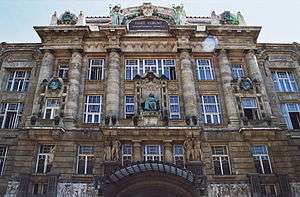Géza Maróti
Géza Maróti (1875-1941) was a Hungarian architect, sculptor, painter, and applied artist.[1]
Maróti was from a rural merchant family and began his career as a woodcarver but later went on to complete studies in Budapest and Vienna.[1] He settled in Zebegeny before the outbreak of World War I and went on to complete numerous commissions both as an architect and a sculptor for public building projects. His work, a cultural history of Atlantis, is still unpublished.

The eclectic building of the Liszt Ferenz Music Academy (1907) in Budapest which is adorned with Maroti's sculptures
Major works
(buildings with sculptures executed by Maróti unless otherwise stated)
- 1904-1907. Franz Liszt Academy of Music, Budapest.
- 1905. Gresham Palace, Budapest.
- Lending bank, Budapest.
- Trading Bank, Budapest.
- 1905-1910. Pest National Savings Company, Budapest.
- 1906. International exhibition pavilion, Milano. The original burnt down but its predecessor won Maroti a number of awards and prizes.
- 1908. Mexico City Teatro Nacional (Mexican National Opera Theatre) today it is called the Palacio de Bellas Artes: sculptures, mosaic work and the dome.
- 1911. World exhibition pavilion, Torino.
- 1912-1914. Maróti villa, Zebegény: sculptures and fountains.
- 1927-1932. Detroit buildings bronze and granite sculptures and decorations. Other American works:
- Fisher Building, Detroit, Livingstone Memorial lighthouse, Cranbrook Academy of Art Museum, Foreman Bank Building, Hurison Motor Co. Building (likely the Hudson Motor Car Company building), Times Building.
- Lagymanyos plans, never built, for oval and university sport precinct
- 1938. Országzászló, Heroe's square with Christ memorial at calvary hill, Zebegeny. Unfinished due to the war and Soviet takeover of power.
- 1933-1940. More than 600 page study on the lost city of Atlantis which was finished in German but translated into English but not published.
gollark: Well, there is, in the form of the GTech Integrated Shield Defense System™.
gollark: <@465216754684002305> I don't know if I explained it to you, but there are ways through RFT force fields.
gollark: TC6, 6.1, potatOS Tau, whatever.
gollark: Frankly, I don't know at this point.
gollark: It might be.
This article is issued from Wikipedia. The text is licensed under Creative Commons - Attribution - Sharealike. Additional terms may apply for the media files.